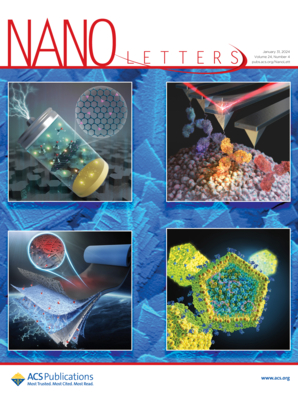设计具有双峰孔隙度的三维纳米多孔Cu/Cu2O (Bi)作为高速率、高容量锌阳极主体。
IF 9.1
1区 材料科学
Q1 CHEMISTRY, MULTIDISCIPLINARY
引用次数: 0
摘要
我们报道了一种双峰纳米多孔Cu/Cu2O掺杂铋(np-Cu/Cu2O (Bi))通过铝-Cu-Bi基两相前驱体合金的脱合金。与通常使用的单峰多孔Cu不同,双峰结构提供了大孔隙(数百纳米)以获得足够的Zn沉积(高容量)和小孔隙(10纳米),具有高比表面积以获得高速率。此外,Bi掺杂后形成的Cu2O表面显著降低了Zn沉积过电位。在50 mA cm-2的大电流密度下,np-Cu/Cu2O (Bi)基半电池和对称电池均表现出较低的Zn沉积过电位(88.7 mV)和优良的循环稳定性(超过260 h),明显优于纯Zn基电池和大多数报道的结果。枝晶问题和副反应也在很大程度上受到双峰纳米孔结构设计和表面修饰的限制。这项工作为通过孔隙度设计和表面化学调制来开发先进的锌阳极提供了灵感。本文章由计算机程序翻译,如有差异,请以英文原文为准。
Designing 3D Nanoporous Cu/Cu2O (Bi) with Bimodal Porosity as a High-Rate and Capacity Zinc Anode Host.
We report a bimodal nanoporous Cu/Cu2O doped with bismuth (np-Cu/Cu2O (Bi)) by dealloying an Al-Cu-Bi-based two-phase precursor alloy. Different from the typically used unimodal porous Cu, the bimodal structure provides big pores (hundreds of nanometers) for enough Zn deposition (high capacity) and small pores (10 nm) with a high specific surface area for high rates. Moreover, the formation of the Cu2O surface with Bi doping significantly reduces the Zn deposition overpotential. The np-Cu/Cu2O (Bi)-based half cells and symmetric cells exhibit much lower Zn deposition overpotential (88.7 mV) and excellent cycling stability (over 260 h), respectively, even at a large current density of 50 mA cm-2, obviously outperforming the pure Zn-based cells and most reported results. The dendrite issue and side reaction are also largely limited by the bimodal nanoporous structure design and surface modification. This work provides inspiration for developing an advanced Zn anode through porosity design and surface chemistry modulation.
求助全文
通过发布文献求助,成功后即可免费获取论文全文。
去求助
来源期刊

Nano Letters
工程技术-材料科学:综合
CiteScore
16.80
自引率
2.80%
发文量
1182
审稿时长
1.4 months
期刊介绍:
Nano Letters serves as a dynamic platform for promptly disseminating original results in fundamental, applied, and emerging research across all facets of nanoscience and nanotechnology. A pivotal criterion for inclusion within Nano Letters is the convergence of at least two different areas or disciplines, ensuring a rich interdisciplinary scope. The journal is dedicated to fostering exploration in diverse areas, including:
- Experimental and theoretical findings on physical, chemical, and biological phenomena at the nanoscale
- Synthesis, characterization, and processing of organic, inorganic, polymer, and hybrid nanomaterials through physical, chemical, and biological methodologies
- Modeling and simulation of synthetic, assembly, and interaction processes
- Realization of integrated nanostructures and nano-engineered devices exhibiting advanced performance
- Applications of nanoscale materials in living and environmental systems
Nano Letters is committed to advancing and showcasing groundbreaking research that intersects various domains, fostering innovation and collaboration in the ever-evolving field of nanoscience and nanotechnology.
 求助内容:
求助内容: 应助结果提醒方式:
应助结果提醒方式:


